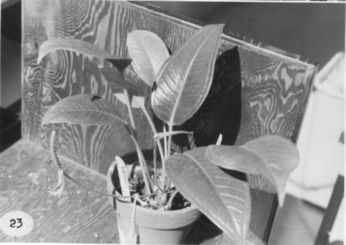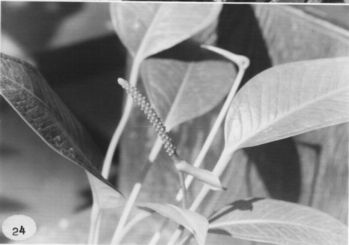





TYPE: Panama. Darien: Cerro Sapo, Hammel 7258 (MO 2822901, holotype; B, K, PMA, US, VEN, isotypes; Live at MO).
Epiphyte; stems short, ca. 1.5 cm diam.; leaf scars obscured by roots and cataphylls; roots green, moderately thin, descending; cataphylls moderately thin, 3-4.7 cm long, rounded at apex, minutely apiculate, drying medium brown (B & K. Yellow 6/5), weathering to reticulate fibers at base, persisting intact at apex.
LEAVES erect-spreading; petioles 12-23 cm long, 3÷4 mm diam., subterete, shallowly sulcate, the margins sharp; geniculum 2-2.5 cm long, scarcely thicker and paler than petiole; blades elliptic to narrowly ovate, subcoriaceous, abruptly to gradually acuminate at apex, acute to obtuse at base, 10.5-18.5 cm long, 6-9.2 cm wide, broadest at middle or just below; both surfaces semiglossy, the upper surface medium green, eglandular, the lower surface slightly paler, densely glandular-punctate; midrib acutely raised above, sunken at apex, convexly raised below; primary lateral veins 10-12 per side, departing midrib at 40° angle, sunken, giving blade a more or less bullate appearance particularly in older leaves, raised below, running straight to collective vein; interprimary veins sunken above, more or less obscure below; lesser veins obscure; collective vein arising from base, 3-5 mm from margin, forming an acute angle with margin near apex, sunken above, raised below.
INFLORESCENCE spreading, equalling or shorter than leaves; peduncle terete, 12-26 cm long, 2-4 mm diam.; spathe moderately thin, yellow-green (B & K Yellow-green 6/7.5), narrowly lanceolate, 2.5-4 cm long, 0.6-1.3 cm wide, broadest near base, gradually acuminate at apex, acute at base inserted at 45° angle on peduncle, erect-spreading; stipe 1-2.5 cm long, becoming elongate after spathe opens; spadix yellow-green (B & K Green 6/2.5), 3-6.8 cm long, 4-5 mm diam. near base, ca. 2 mm diam. at apex; flowers rhombic to sub-4-lobed, 2.7-3 mm long, 2.5-3 mm wide, the sides sigmoid; 3-5 flowers visible in the principal spiral and 5-6 flowers visible in the alternate spiral; tepals semiglossy, densely papillate, lateral tepals 1.3-1.5 mm wide, the inner margin straight to weakly convex; pistils pale green, weakly emergent or emergent to ca. 1 mm in larger plants; stigma linear, exserted, brush-like; stamens emerging in a complete sequence from base, laterals first, followed quickly by alternates, the laterals emerging 2-3 spirals ahead of alternates, exserted on short, broad, translucent filaments ca. 0.4 mm long, ca. 0.5 mm wide, retracting to hold anthers at edge of tepals (held at sides of pistil when pistils are more emergent), persisting against sides of pistils, not contiguous; anthers ca. 0.3 mm long, 0.5 mm wide; thecae ovate, not divaricate; pollen white.
INFRUCTESCENCE spreading; berries pale lavender, globose, depressed at apex, 0.8-1 cm long, 1-1.1 cm diam., mesocarp pulpy, white; 5-6 seeds, green, 2.5-3.2 mm long, 2.3-2.5 mm wide, brown at apex with short appendage. Figs. 23 and 24.
Anthurium barryi is endemic to Panama in the Serrania del Sapo in southwestern Darien Province at about 1,000 m in premontane rain forest.
The species, a member of section Porphyrochitonium, is distinguished by its small size, its epiphytic habit, its short, slender stem with persistent cataphylls, its sulcate petioles almost equalling to greatly exceeding the length of the blade, and by its elliptic to ovate-elliptic, glandular-punctate blades. It is also especially distinguished by its long-pedunculate inflorescence equalling or exceeding the leaves with an unusually long, stipitate, green to yellow spadix and green or pink to purplish, narrowly lanceolate spathe. In more mature plants the pistils may be emergent up to about 1 mm whereas in smaller plants the pistil is scarcely emergent before stamens appear. In extreme cases the stipe may almost equal the length of the spadix. In living plants the blades are arched along their midribs with etched primary lateral and collective veins.
The species is named in honor of Barry Hammel who was the first collector to climb Cerro Sapo while he worked for the Missouri Botanical Garden in Panama during 1979. It is not close to any other described species in the section, although it superficially looks like Anthurium umbricolum Engl. from Ecuador that diners in lacking dark glandular punctations on the blades.
 |
 |
Mesoamerican Specimens
Panama Darien: Cerro Sapo, 2500 ft.,, , Hammel 7258 (CAS, F, MEXU,
NY).
DARIEN: Cerro Sapo, Hammel 1162 (MO, PMA), 1163. 1164, 1165
(MO), 7258 (B, K, MO, PMA, US, VEN)
South American Specimens
Colombia Antioquia: 670 m,, 20 Mar. 1982, Hernandez, J. & S. Hoyos
257 (HUA).
.